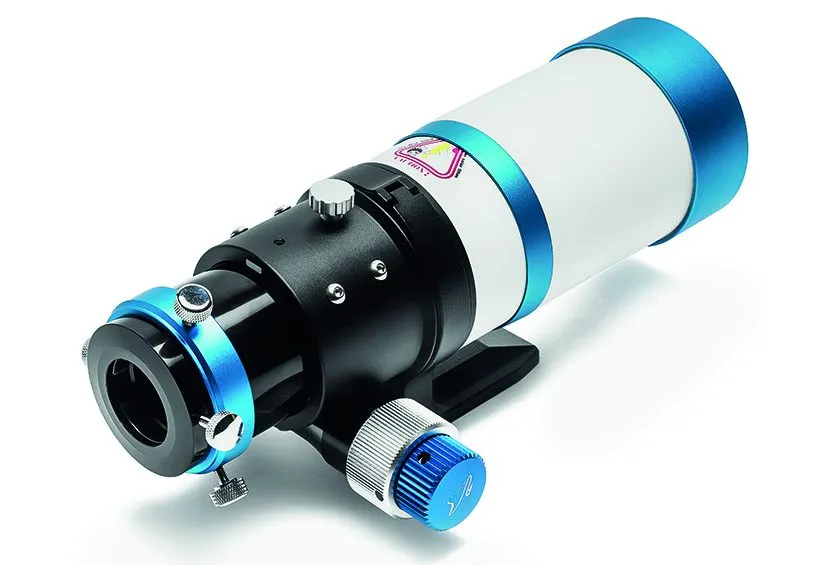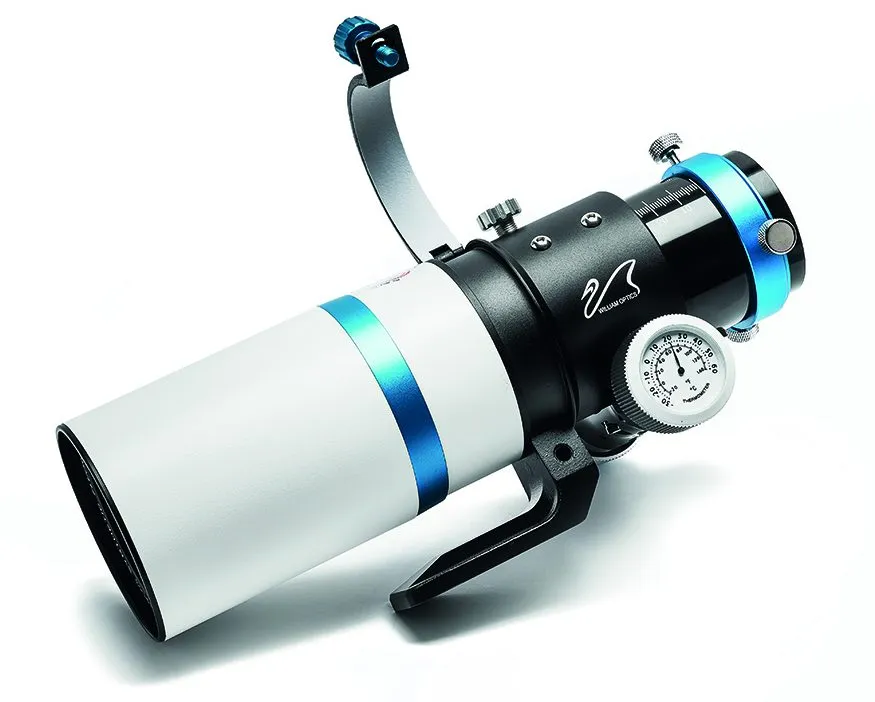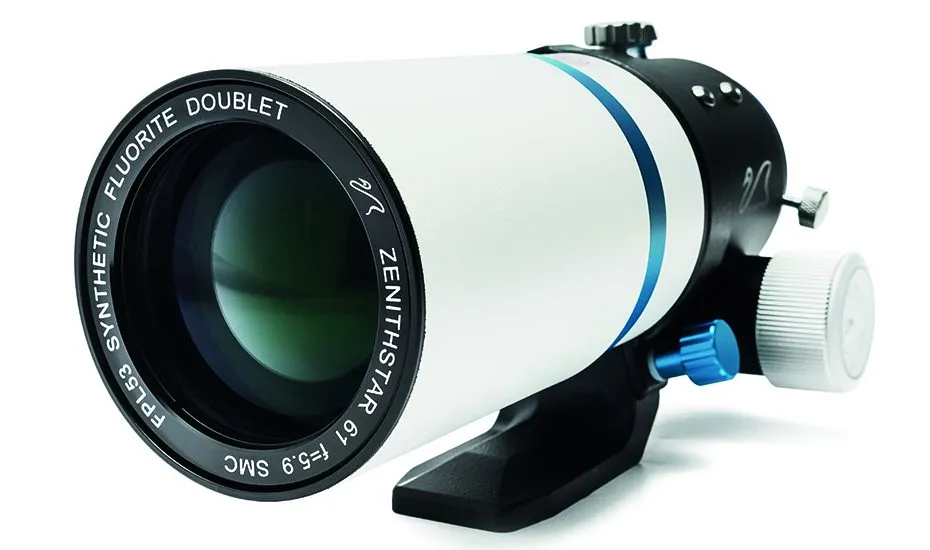Dragging a large, cumbersome telescope with you on holiday soon loses its appeal and this is where portable scopes like the William Optics Zenithstar 61 (ZS61) come into their own.
Dark skies can be something of a luxury if you live in an urban environment and you may find you have to travel to escape the light pollution and see the cosmos at its best.Or perhaps you’re lucky enough to holiday somewhere where the skies are dark and the opportunity for looking up is irresistible.
In terms of portability it’s difficult to imagine how you could improve on this William Optics 61mm aperture refractor’s design.In its most compact form it measures just 23cm long by 14cm wide. It’s also pretty light at 1.7kg but retains a solid, well-built feel.
The front of the instrument has a retractable dew shield that extends the overall length by a further 7cm.For such a small scope we were really impressed with the attention to detail.
The ZS61 uses a dual-speed rack-and-pinion focuser which we found smooth and precise to use.An adjustment thumbscrew allows you to alter its feel to suit your own preference.
One of the focuser dials has a rotary thermometer built in so you can even record the temperature while observing.

At the front end there is a colour coordinated lens cap that fits on the dew shield. This contains a focus aid accessed by unscrewing a metal end-plate.
Inside is a Bahtinov mask, an optical device created from a number of inclined parallel slots through which starlight can pass. The slots produce a pattern that aids accurate focusing.
The front objective is an air-spaced doublet formed from low dispersion FPL-53 ED glass. This produces lovely colour-corrected views.
We were hard pressed to see any rogue colour fringing at all on bright stars or the Moon.
The scope’s 61mm aperture and natural focal length of 360mm gives the ZS61 a focal ratio of f/5.9, which is neither particularly fast nor slow.
It’s important to be realistic with the ZS61’s aperture. It produces lovely views of larger deep-sky objects and the Moon but it can’t break the laws of physics.Such views will typically be low power and of limited resolution.
If you’re after detailed views of the planets, are into hunting small lunar features or splitting tight double stars, this isn’t the scope for you.
But if you want an ultra-portable instrument that can provide good contrast, colour-corrected views of extended objects, it’s perfect.

Through the eyepiece stars appeared sharp and bright. We loved the views it gave of large open clusters such as the Pleiades and the Beehive Cluster.
The Double Cluster looked amazing too, like spilt sugar on a dark velvet background.We also loved the enhanced overview of the Moon this scope gave.
The contrast was excellent, with dark shadows looking inky black against the bright lunar highlands.
One area likely to attract interest is the ZS61’s use for astrophotography. Carrying an ultra-portable telescope and camera provides a fantastic opportunity to make the most of dark-sky locations.
Here the Bahtinov focus mask and smooth, responsive focuser work really well together.
Using a Live View-enabled DSLR, diffraction patterns produced by the mask were relatively easy to see and we were able to reach perfect focus with ease.
One slight disappointment is a distortion across the imaging frame.
Stars appear sharp at the centre of the field but become progressively stretched out towards the frame edge and corners.
This can be addressed by using a matching field flattener and for the ZS61 the William Optics Flat61 is the device to go for.
This optional extra is a must if your objective is astrophotography and will set you back around £149.
If portable astronomy is important to you, the William Optics Zenithstar 61 is a very tempting and reasonably priced option.
Coupled with the optional field flattener and one of the many portable battery-driven equatorial mounts currently available, all you need to do is hunt out those dark skies.

Impressive optics
The ZS61 has a 61mm objective lens made from two FPL-53 extra-low-dispersion (ED) glass elements.
FPL indicates that the material contains fluorite (or a synthetic form of fluorite) and lead (chemical symbol Pb). The ‘L’ means that the material is low dispersion.
This creates an optical material that has very low chromatic aberration, ideally suited for colour-corrected telescope optics.
The two lens elements are air spaced to form a doublet lens. Each element is designed to bring the two ends of the visible spectrum to a convergent focus.
All this adds up to a lens with virtually no unwanted colour fringing.
Further refinement is provided by super-multi coatings (SMCs) to reduce unwanted refraction and reflections.
Inside the optical tube, circular baffles are fitted as field stops, limiting the field of view to just that provided by the objective lens.
This helps reduce unwanted effects such as off-axis light reflected from inside the optical tube, and further increases the quality and contrast of the view.

Optical tube
The ZS61’s optical tube is made to a high standard and attractively finished in white. It has highlighted colour accents around the base of the dew shield, the lens caps and Bahtinov mask, and the slow focus knob. Gold, blue and red variations are available.
Retractable dew shield
A dew shield does exactly what its name suggests: shield the objective lens from moisture build up. In the case of the ZS61, the front dew shield extends by 7cm from its retracted travel position. The motion is smooth and the shield holds position when pointed at high inclination angles.
Focuser
The 2-inch, 1:10 dual-speed focuser is fitted with a triple-screw compression ring. A 1.25-inch adaptor is also included as standard. Four hex screws allow the focuser tension to be adjusted, with a larger thumb screw for quick adjustment. The rack-and-pinion focuser provides 70mm of travel and has a millimetre scale printed on the draw tube.
L-type bracket
The ZS61’s optical tube has a recessed channel around which is a ring clamp connected to an L-type bracket. Scope orientation is adjusted by loosening the clamp then locking it with a thumb screw. The L-shaped foot is Vixen compatible and has two ¼-inch and one 3/8-inch threaded holes on its underside.
Bahtinov mask
The ZS61’s lens cap has a threaded top that unscrews to reveal a Bahtinov mask – an optical arrangement of slits that produce diffraction spikes when starlight passes through them. When the spikes appear sharpest and pass through the same central crossing point, the scope is focused. Once focused, the collar containing the mask is removed.
Vital stats
- Price£415
- OpticsFPL-53 air-spaced doublet, fully multi-coated
- Aperture61mm
- Focal length360mm, f/5.9
- Focuser1:10 dual speed rack and pinion
- Dew shieldRetractable
- MountingRotatable L-bracket
- ExtrasBahtinov mask, thermometer
- Weight1.7kg
- SupplierWidescreen Centre
- Tel01353 776199
- www.widescreen-centre.co.uk
This review originally appeared in the March 2019 issue of BBC Sky at Night Magazine
